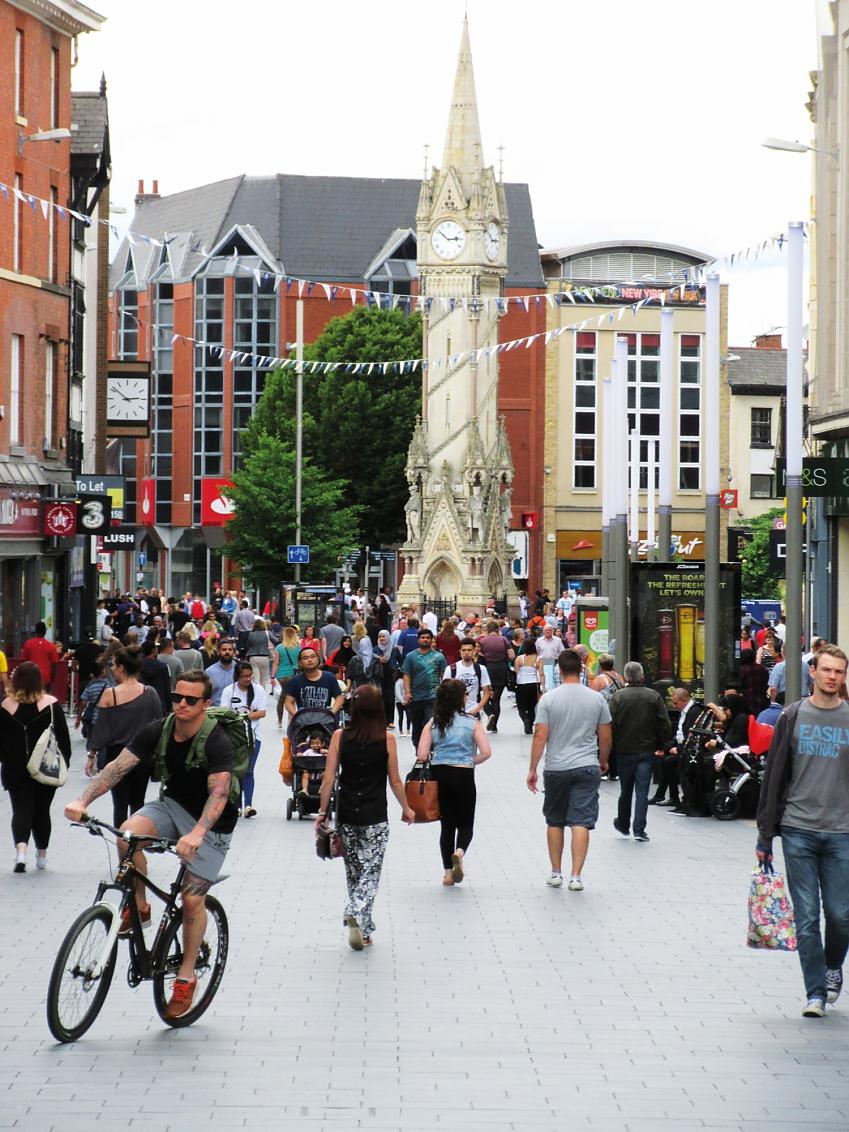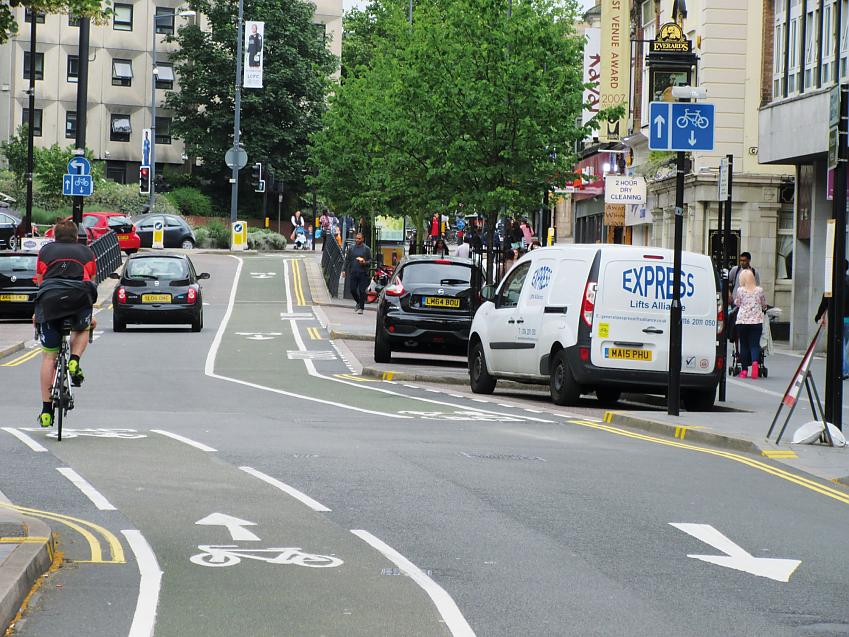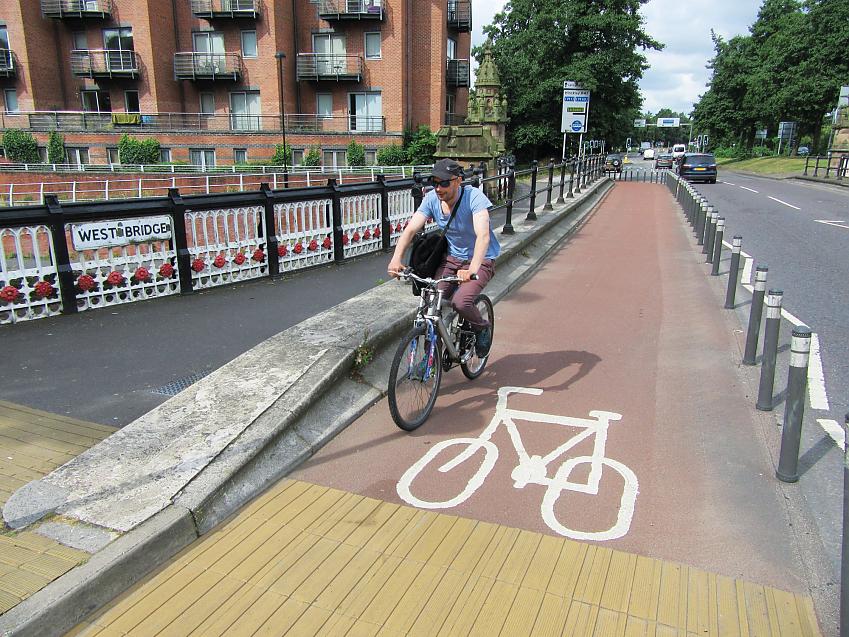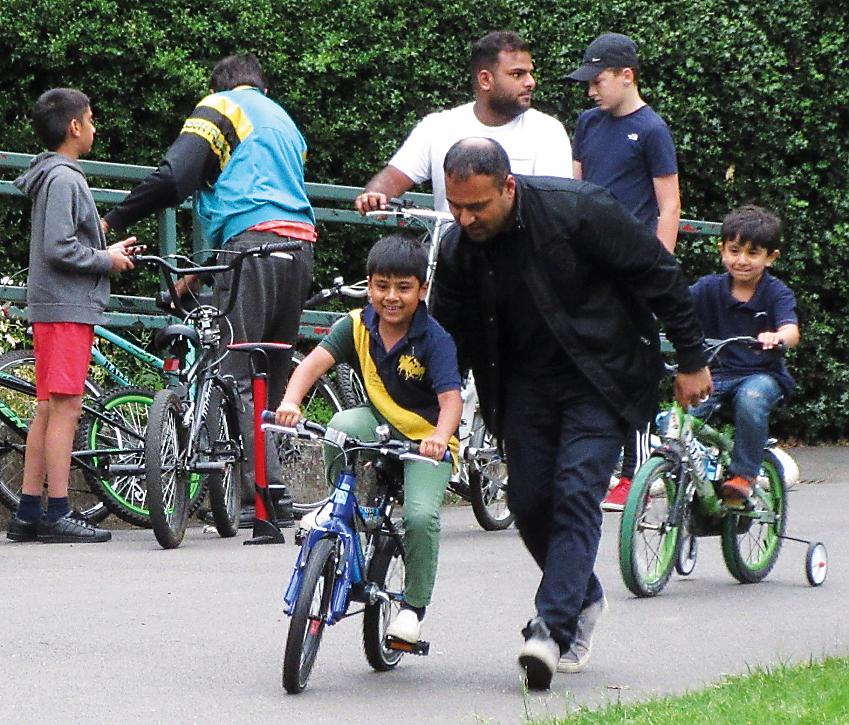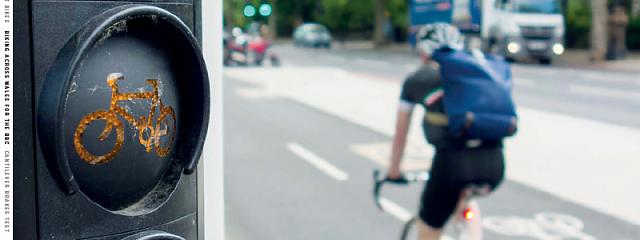
Lessons from Leicester
Lessons from Leicester
London has its Cycle Superhighways, Cambridge its everyday-biking culture. Which other towns and cities make the showcase-cycling list? Big cities don’t fare well: Manchester and Birmingham, for example, have some usable bike routes but they’re few and messy. Stevenage has a once-pioneering cycle track network, but car-oriented town planning has produced low cycling levels. Leeds’ new ‘superhighway’ to Bradford includes great sections but also some absurdly narrow cycle tracks where the space gets squeezed by bus stops. Where, then? York, Bristol, Plymouth...?
A surprise recent contender for the roll-call is Leicester. It’s no biking mini-Holland; it’s about as Dutch as a pork pie. But thanks to planning vision, smart use of funding, and most notably political will, it’s achieved some very good things without any special cycle cash – things many other town and city centres would do well to emulate.
In July, I cycled round the city for a few days to see it first-hand. Pedalling into the centre from the south-east – through Victoria Park, with the gentle stream of morning commuters and university students – is like many UK cities: a mix of makeshift main-road cycle lanes, pleasant green-space paths, and unfoolproof signed-mazes through back streets. So far, so ordinary.
Shared spaces
It’s only once you get in the centre that you see what’s unusual about Leicester. A huge area is pedestranised: properly, with wall-to-wall flagstones, not kerbs or road-like paving. And bikes are allowed – specifically, ‘considerate cycling’ – everywhere, any time. Cyclists slip through the crowds, most bare-headed and in everyday clothes, and the whole range of Leicester’s famous ethnic mix is visible on two wheels.
The non-pedestrianised central streets are nicely permeable for bikes too, with contraflows common. Granby St, linking the railway station with the centre, even manages to have them in both directions. It makes getting across the centre easy and pleasant: you can head confidently to your target along your desire-line. The station, the clock tower, the Richard III museum? No problem, follow your nose. (Richard apparently died from a head injury and wasn’t wearing a helmet; it wouldn’t have saved him, though.)
You can even cycle along the covered market where the family of another famous Leicester son, footballer Gary Lineker, still has a fruit and veg stall. For the small number of delivery cyclists – shuttling curries in Deliveroo backpacks, or crates of recycling on cargo bikes – this must be a good place.
Shared-space plans don’t always work out. Exhibition Road in west London, for instance, got its ‘naked street’ project very wrong. Pedestrians, bikes and cars should have been mingling in a piazza-like paradise. In fact, motor traffic continues to speed down the ‘road’ section while pedestrians take refuge down the ‘footway’ section, and bikes are forced onto the ‘road’.
Leicester, on the other hand, is getting it right. Most encouragingly, road space has recently been reallocated from drivers to people on bikes in many places. The wide cycle tracks along Newarke St and Welford Rd, important access routes to the centre, for example; or West Bridge across the river, where a cycle track is marked off from the carriageway with ‘wands’ (light, semi-permanent plastic bollards).
Wise council
Leicester’s shift of priorities away from motor traffic started in 2005, with redevelopment based on pedestrianisation. Significant cycle facilities were installed between 2010 and 2012, and development continues, with red-and-white roadworks barriers in several places on my visit.
The bike-friendly layout was part of the vision, but the details came from urban designers rather than cycle campaigners, according to the council’s Cycling Co-ordinator Andy Salkeld. It has resulted in a doubling of cycling and walking in that central area. Reported pedestrian-cyclist conflict is only at the same level as it was before, when bikes were very restricted. Evidently, decent provision encourages the right sort of cyclists, who happily coexist with people on foot. Police are happier too; the previous regime was a headache to enforce.
These days, the council are keen to stress their promotion of sustainable transport. They’re careful how they phrase it, though, to make it positive rather than ‘anti-motorist’. ‘The language used is about improving foot access, reducing congestion and pollution,’ says Andy. ‘About liveable streets, space for all abilities, active travel, and planning for people, not cars.’
The money has come from a variety of sources, none cycle-specific: lottery money, heritage funding, European Regional Development and so on. And Adam Clarke, the assistant mayor, is positive that it’s been money well spent. For him, ‘the arguments for pedestrianisation were essentially economic. What’s good for people – a clean, healthy, attractive city – is also good for business.’
He points to Jubilee Square, once a car park, now a pleasant (and bike-friendly) public space by the cathedral. (The parking spaces have been shuffled across to a nearby NCP operation which was previously under-utilised.)
Reallocating road space
The council also works with incoming employers to keep cycling high up their agenda, such as with IBM and Hastings, two companies moving into large central buildings. IBM is currently turning 18 of their 20 car spaces into cycle parking and other storage options – a win-win, given the young and active nature of a typical techie workforce.
‘The next step is breaking the “concrete collar”, the 1960s inner ring road,’ says Andy. Pedestrianisation is being extended and surrounding buildings are being refurbished across the city centre. Now there’s also a ‘strategic shift beyond the city centre, to road space reallocation along primary routes to create safer space for people on foot, bikes and buses’. A notorious flyover at Belgrave Road was recently demolished, literally paving the way for less car-centric redevelopment, and those Newarke Street and Welford Road paths are intended to be the start of something much longer.
Such upgrading can’t come soon enough to the Golden Mile, Belgrave Road’s parade of lively Indian restaurants and shops. An old-style urban dual carriageway, it’s nasty to cycle, especially coming from the safety of the centre: within a minute I’d been close-passed twice and yelled at for no good reason. Public consultations are looking at ways to make it more human-friendly.
Leicester’s progress has come thanks to strong support from a pro-cycling elected mayor, Sir Peter Soulsby. It’s reminiscent of London’s recent segregated Cycle Superhighways going ahead on Boris Johnson’s nod, or the earlier pedestrianisation of upper Trafalgar Square under previous incumbent Ken Livingstone.
The city’s timing was fortunate, too, with most of the large-scale works being finished just before the 2008 recession (in contrast to say Bradford, which saw major projects stall). And, reckons Adam, they’ve been helped by a ‘we’ll do it anyway’ attitude
What’s working & what’s not
There are many excellent things to celebrate: 13,000 people now cycle regularly in Leicester, a third of them for work, the rest for leisure and social. There are lively community projects too, some with council help and some without. A good example is the weekly Evington Park cycle club, where local volunteers help local kids (and adults) develop riding skills in a safe, supportive and fun environment. I spent a Monday evening there, and the sheer delight, enthusiasm and good spirits are a pleasure to be part of, as parents and children whirl round the calm green space.
So there’s been genuine progress, but Leicester still has some way to go. Many cycle tracks (Groby Road, Welford Road) require cyclists to give way to side roads – those in a hurry may well stick to the road unless traffic is heavy. Gaps in the network remain, where puzzled cyclists find themselves suddenly riding on the footway.
Levels of cycling remain low – at 2% of journeys, the same as the measly national average outside central London or Cambridge. You’re as likely to see pedestrians using those showcase cycle tracks as you are cyclists, and some local drivers treat them as parking spaces, ‘excused’ by hazard warning lights.
And safety continues to be a major issue. During the research for this article, a young man was killed while cycling on the busy London Road right outside the railway station. There’s a parallel traffic-free route, New Walk, which being wide and straight would be perfect as an alternative – but for 200 years it’s been strictly promenaders-only, and so far it looks like staying that way.
Campaigners’ verdicts
What do local cyclists and campaigners think of their city? In the course of my few days riding around Leicester, I talked to many: some informally in the street; some in long and well-considered email exchanges; some (my welcoming and generous hosts, Shirley and Lee) over a convivial dinner. Everyone was carefully positive, but realistic. No over-enthusiasm but no moaning either. Leicester’s a place in the sensible middle.
Take the verdict of Leicester Cycle Campaign Group (LCCG) member Chris Williams, for instance: ‘Hardly any of it is a waste of money, and I appreciate that they’ve got the guts to spend it when they are facing horrendous cuts and haven’t been favoured with any cycle city cash. But check out the Granby Street contraflow in any evening to see a short-stay car park. They need enforcement or it becomes worse than useless.’
Fellow LCCG member Elizabeth Barner, who’s on the committee for Cycling UK’s Space for Cycling, sees many pluses too: ‘I’m very pleased with the south side of St Nicholas Circle’ she says. ‘This is a huge roundabout around a Holiday Inn, crossing the River Soar twice. The south side took out a lane of traffic, including over the bridge (West Bridge, where LCCG campaigned successfully for those wands). It has every type of infrastructure going arrayed across it, but it works, and pedestrians love it too.’
She points to an example of the mayor ‘being really quite good: he wanted Newarke Street changed, and put the lane on the north side because it gets more sun and will be more pleasant to use.’
The big challenge for Leicester now, Elizabeth says, ‘is connecting where people live to the centre. Apart from the Great Central Way (National Cycle Network Route 6), Route 63 going west works for a while. But seeing the intimidating route along London Road is eye-opening.’
Cycle-commuters who live east of the centre have no decent ways in either, as I found out when I rode along the hectic Humberstone Road/Uppingham Road artery. However, that NCN6 is a cracker, with some gorgeous leisure riding along riversides and rail-trails running conveniently north-south through the centre.
Above all, Elizabeth says, ‘Leicester is a city of multicultural neighbourhoods. I think it’s very important to understand that, and to consider transport alongside a cultural understanding of how neighbourhoods are used.’ Less than half of the city is white British; almost a third is Indian; the rest are from all over, including Eastern Europe, Africa, the Middle East, the Caribbean, China... (To experience the range, ride along Narborough Road, said to be the country’s most diverse shopping-and-eating street.)Do it like Leicester
Tom Guha, who’s responsible for Space for Cycling at Cycling UK, is enthusiastic about what Leicester has shown. ‘It’s a shining example of bike-friendly redevelopment,’ he says, ‘and shows what can be done, independent of central government, if the political will is there. It also dispels myths about cyclists and pedestrians sharing space on traffic-restricted streets in town centres. Leicester is proof that it can work safely.’
The city’s unsung football team made world headlines when they won the Premiership in 2016. They’d been favourites for relegation with their team of low-budget non-stars (well, relatively low-budget: millions rather than tens of millions). But canny management and a great team effort brought them an astounding sporting achievement. Maybe there are parallels here with cycling infrastructure...?
Leicester still has a way to go to be an English Groningen or Assen. But returning to my home town of York, I realise how far ahead, in British terms, Leicester is. York’s historic centre is half-heartedly pedestrianised, simultaneously banning cyclists during shopping hours, yet somehow allowing dozens of cars with disabled badges and trucks to block the ‘footstreets’. Leicester (which obviates the need for cars for the disabled in the shopping area by providing mobility scooters) shows that bike-friendly space-sharing can benefit everyone.
So maybe we should all get on to our councils, elected mayors if we have them, and other decision-makers, and encourage them to go on a fact-finding mission to Leicester. They’ll get some rather fabulous opportunities to eat out in a range of cuisines. More importantly, they’ll see that giving Space to Cycling really can work, for everyone’s benefit.
Space for Cycling
Created by the London Cycling Campaign in 2014, Space for Cycling has been taken nationwide by Cycling UK. The campaign calls for local councillors to pledge support for Space for Cycling. Focus has been primarily given to creating protected space on main roads, creating traffic-free routes, and reducing traffic volumes and speeds. Around 600 councillors outside of London currently support the campaign.
We are now preparing for a second phase of the campaign. This time we will focus on getting whole councils to commit to:
• Plan entire cycle networks.
• Invest fully in the network, so it can be properly implemented.
• Build the network in accordance with up-to-date, high-quality design standards.
A piecemeal approach is not enough. For cycling to be a truly safe, attractive and convenient form of transport, good cycling conditions must exist everywhere.
You can help!
To call on your councillors to support Space for Cycling, visit: space4cycling.org.uk
Even better…
• Get involved with your local campaign group.
• Help your council plan a network.
• Do you have graphic design skills? We need you!
For any of the above, contact Cycling UK’s Space for Cycling Campaigns Officer, Tom Guha: tom.guha@cyclinguk.org






